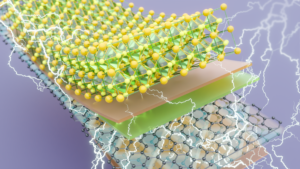Grant number N00014-23-1-2567
When two crystals are stacked, the interactions between them can lead to new properties not seen in either constituent. Historically such stacking has been limited to materials with matching lattice constants grown epitaxially. The advent of van der Waals (vdW) materials have now removed these restrictions, allowing the stacking of materials with arbitrary thicknesses, crystal structures and orientations. Notably, twisting two crystals provides unique control over their symmetries, electronic, and optical properties.

This emergent field of twist-optics seeks to exploit this new degree of freedom and promises to be transformative, in enabling new paradigms for dynamically manipulating light with exotic polarization and chirality for optical communication, sensing and thermal transport. Yet despite this promise, the design space is exceptionally broad, including a suite of vdWs materials and their suite of thicknesses, twisted misorientations and layer number, thereby making device design and fabrication exceptionally challenging. In this proposal we seek to develop a generalized model driving material selection, integration, and layer misorientation, and how they dictate emerging electronic, photonic and electro-optic properties within the linear and nonlinear regimes. We seek to develop an iterative design workflow that integrates first principles calculations of materials properties, material design, material fabrication, and testing. Our process flow will include not just the electronic interactions between two vdW materials, but also bulk materials and artificial metasurfaces, expanding the impact of twist-optics by including artificial materials with designable optical response, and/or integration within conventional semiconductor optic and electro-optic devices. We seek to address three fundamental questions: 1) What is the role of crystal twist in dictating interlayer electronic and polaritonic coupling, and emergent symmetries in regard to driving novel optical and optoelectronic processes? 2) How can we control the scale of localization and slow light using moiré and twist-optic phenomena in heterogeneous systems to amplify optical and optoelectronic processes? 3) How can the influence of lattice twist induced changes in vdWs forces be generalized for the control of polaritonic losses and their scattering phase space, especially between distinct modes?
We propose to answer these questions through our three tasks and fabrication processes outlined in our Tasks page. Our research will show how these concepts can be employed to create wavelength conversion components, eye safe laser technologies, chiral sensing of molecular enantiomers, polarization optics and electro-optic modulators. Crucially, these new technologies will be significantly smaller than current generation components. Through integrating these components with existing technologies, these have the potential to enable revolutionary internet-of-things edge computing and sensing applications for military or security. These include self-driving or -flying military vehicles, augmented reality night goggles, and self-targeting weapons with ability to see around corners or noisy environments addressing many of the key priorities for the DoD research as illustrated by the potential impact of this work upon multiple Naval S&T Focus Areas.